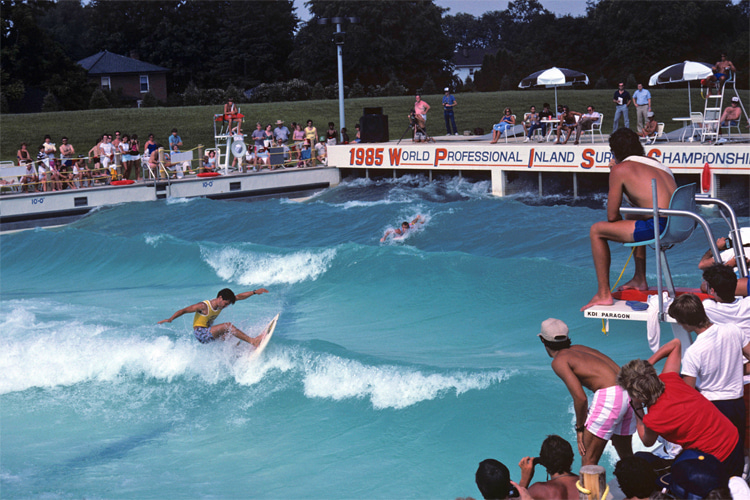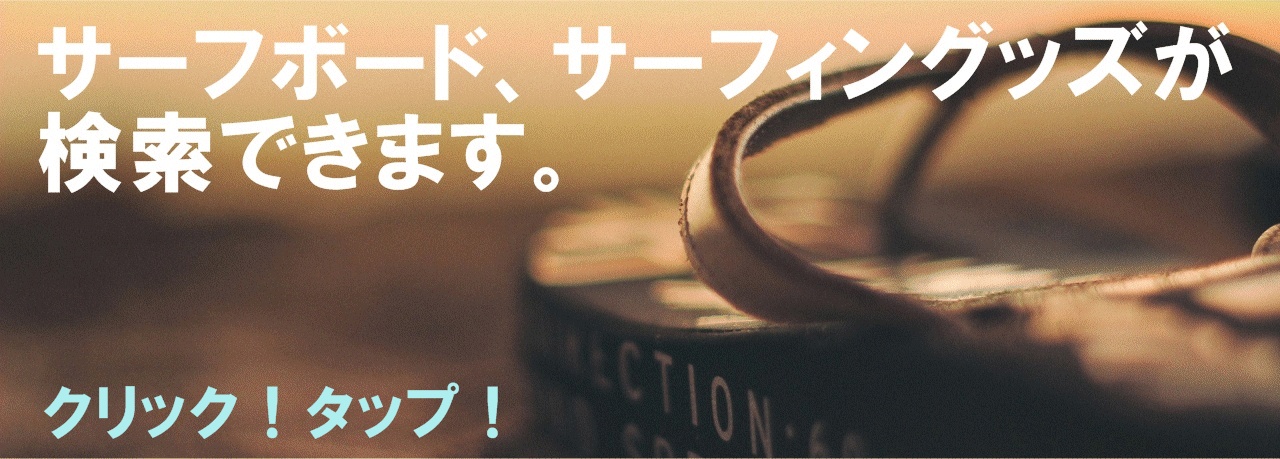Wildwater Kingdom: the world’s first pro tour wave pool

The first-ever pro tour wave pool contest was held at Dorney Park & Wildwater Kingdom in Allentown, Pennsylvania.
The 1985 World Professional Inland Surfing Championship was a unique event run in an unprecedented venue, 90 miles away from New York and 120 miles from the New Jersey shoreline.
The ASP World Tour era had just begun, and Tom Carroll was the star surfer.
The Australian won two world titles – 1983/1984 and 1984/1985 – before signing one of the sport’s first millionaire contracts with Quiksilver in 1989.
Professional surfing wanted to take a leap of faith into the future, whatever it would be, and conquer the mainstream public, a source of unlimited visibility, business, and sponsorship.
The water and theme park industry was growing and becoming largely popular across the United States.
The possibility of having surfing take place inland had been proven possible and successful with the opening of Big Surf in Tempe, Arizona, in October 1969.
Could running an ASP event in a wave pool be a hit?

An ASP World Tour-Sanctioned Event
The history of Dorney Park & Wildwater Kingdom dates back to 1884 when Solomon Dorney created a public attraction.
Initially, it featured playground-style rides, games, picnic groves, refreshment stands, a restaurant, and a hotel.
The facility was owned and operated by the Plarr and Ott families until it was sold to Cedar Point years after the surf contest.
In 1985, several additional attractions were added, including a family water raft ride, tube and body slides, and a children’s water play area.
Robert Plarr, one of the family members who owned Dorney Park, wanted the wave pool built for surfing and contests.
In late 1984, he asked salesman and surfer Jim Karabasz to make it happen no matter what.
“Robert Plarr did something no other major hard park did, and that was incorporate a full – not just a swimming pool – water park into their operations,” Jim Karabasz told SurferToday.
“It was something that did not go unnoticed by the giants of the amusement park world, including Disney, Wet & Wild, Cedar Point, etc.”
Karabasz, who would later teach surfing at Wildwater Kingdom, contacted the founder and executive director of the ASP, Ian Cairns, who flew to Pennsylvania to check for himself the feasibility of the bold venture.
Surf Media Was Hard to Please
Negotiations were short, and bills were paid.
The inaugural World Professional Inland Surfing Championship was really happening from June 19-23, just days after its public opening.
“Everything was completed on time and budget. These people – Plarr and Ott – knew how to get stuff done,” adds Karabasz.
“Bobby asked me to get a ‘big time surf contest” to come here. It was not a ‘carte blanche.’ There was a budget, and the ASP met that.”
Cairns saw an inland surfing tour in the making.
The marketing machine got underway with billboards announcing that surfing was coming to town and TV ads promoting the one-of-a-kind contest.
Surf media was also present to cover the event.
Surfer magazine sent Matt Warshaw, associate editor of Surfer magazine, and Matt George, writer and photographer, to cover the competition.
According to Warshaw, two weeks before the start of the event, the pool was not even functioning because the construction hit a solid granite layer, which reduced the pool’s planned depth by about 50 feet.
Consequently, this also diminished the size of the waves the pool could generate.
Nevertheless, he was open-minded to trying something different in a place surrounded by mountains.
“We both loved competition; there was none of that ‘surfing is art, not sport’ bullshit,” Warshaw once told Twenty Magazine.
“We just wanted the contests to be better. We hated the Op Pro and really hated the idea of having an event in a wave pool.”
Matt George was also not particularly into this format.
“These wave pools at the time were just goofy as hell, and they were right next to Captain Blackbeard’s soapy sudsy bubble ride. They were ridiculous to us.”
Jim Karabasz has another version.
“These two guys were more impressed with one of them winning a $100 ‘Hot Buns’ contest, which all locals knew was just a joke.”
“They acted like it was the most important thing that happened that week when they should have been trying to promote the sport of surfing.”
“It was a first step, not a final product, but these two shot it down because it was easier than acting adult/professional and finding the silver lining.”
“And it was not them winning the ‘Hot Buns’ contest.”

The Allentown Wave Pool
The 12-foot deep, inverted heart-shaped wave pool was around 150-foot long and 150-foot wide in the longest, closing section.
Four steel hydraulic paddle/flaps generated three-foot left and right-hand waves by moving over 100 tons of water every three and a half seconds.
When pro surfers like Tom Carroll, Mark Occhilupo, Glen Winton, Tom Curren, Gary Elkerton, Bud Llamas, Shaun Tomson, Jim Hogan, Rabbit Bartholomew, Jeff Novak, and the other 60 competitors arrived at the inland surf spot in Allentown, reality took over.
Maneuvering was difficult; surfboards did not have enough buoyancy for fresh water, and the size and shape of waves did not even meet the minimum fun level requirements.
Surfers had 20 minutes to get the most out of the continuous swell coming out of the wave machine.
Athletes were frustrated – it could very well be the worst of the 19 events on tour that year.
“The machine had problems, and it broke down a few times. And then we could hear the alarm go off when it overheated every half hour because it was operating at supermax. It was just chaos,” added Matt George.
Once again, Jim Karabasz strongly disagrees.
“The pool produced exactly what the manufacturer and the park expected: two-to-three-foot faces,” the surfer organizer told SurferToday.
“Otherwise, they wouldn’t have gotten paid as there was a performance clause in the construction contract.”
Also, the organizer states that the equipment did not break down.
“The event and practice sessions started and finished on time. There were downtimes due to the water temperature that was used to keep the equipment cool and operational.”
“A workaround was found, and the event went off and finished on time. There was no diminished capacity for wave size as stated in surf media.”
“Speaking of finishing the pool, the wave pool was ‘operational’ as early as mid-April 1985.”
“The wave generation company spent weeks fine-tuning the waves. I surfed it every day.”
“I also worked with Ian Cairns to set up a test day, and he invited surfers Shaun Tompson, Tom Curren, and Freida Zamba to come.”
“The trio rode waves, and we discussed designs needed to work in this environment – freshwater, not powerful waves. Freida, coming from Florida, absolutely ripped these waves.”
“So there was knowledge about these waves before the contest, and almost all competitors came with boards that just didn’t work.”
“The competitors chose to ignore these facts – not my fault, not the park or the ASP’s fault. You know whose fault it was.”

A 33-Year Hiatus
The inaugural, five-day 1985 World Professional Inland Surfing Championship final pitted Tom Carroll against Derek Ho.
The Australian beat the Hawaiian in front of 5,000 ticket-paying spectators and took home $4,500.
American brewing company Anheuser Busch was invited to sponsor the 1986 event with the promise of “an even greater media response.”
However, a second edition never materialized.
The lack of profit and support from surf media and the quality of the artificial waves at the time are cited as reasons for not running another inland surf contest at Dorney Park & Wildwater Kingdom.
Organizers were, according to Jim Karabasz, “pretty unpleasantly surprised by the unprofessional and childish coverage they got from the surf press.”
“It was one of the major reasons there wasn’t a second event.”
The truth is that 33 years later, the World Surf League (WSL), the successor of the ASP, ran a Championship Tour (CT) event at the Surf Ranch in Lemoore, California, the wave pool designed by Kelly Slater.
Wave pools are back in pro surfing. But will they be able to keep us entertained for the next three decades?
Words by Luís MP | Founder of SurferToday.com


